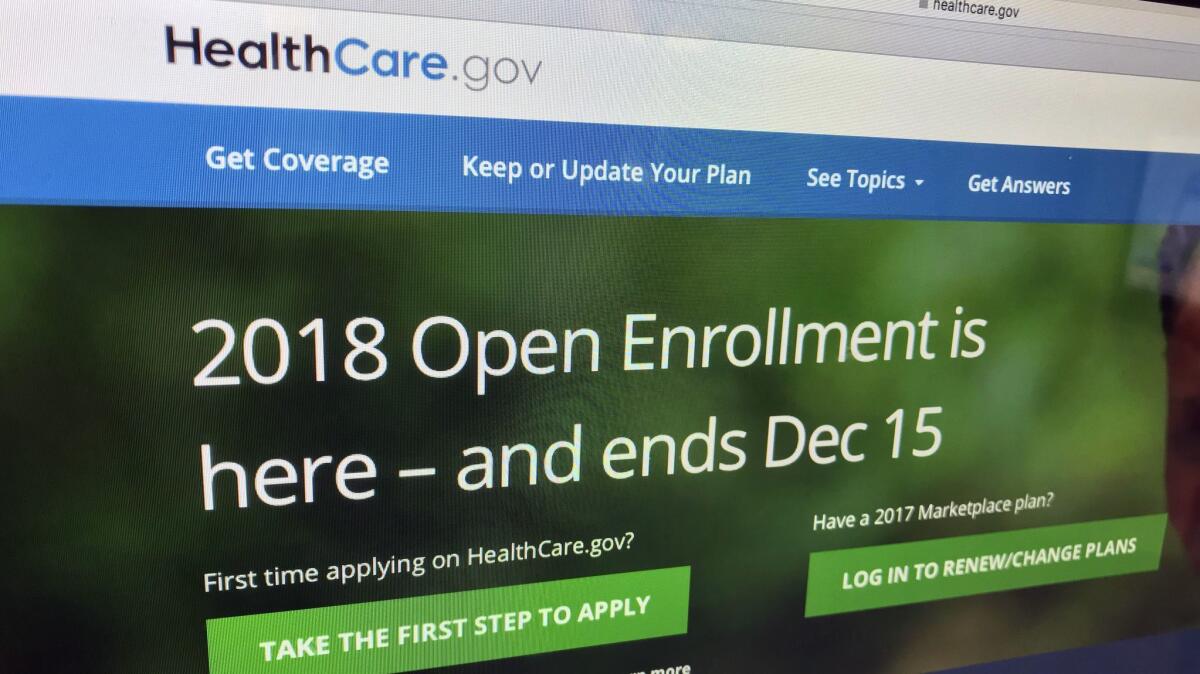Editorial: Another challenge for Obamacare — and a bigger bill for taxpayers

- Share via
Seemingly every move the Trump administration has made when it comes to healthcare has been designed to maximize the harm to the insurance programs launched or expanded under Obamacare. In addition to the president’s (thus far unsuccessful) efforts to repeal the law outright, the Department of Health and Human Services has taken a series of administrative actions that undermine one the law’s main features: the state exchanges where Americans not covered by large employer health plans can shop for policies.
The moves have caused plenty of anxiety, yet the exchanges are enduring. In fact, this year some insurers are expanding their offerings. But insurers are also responding with higher premiums, making coverage significantly more expensive for some of the Americans who shop there and — because the government subsidizes low-income consumers in the exchanges — driving up the cost to federal taxpayers.
In short, Trump’s zeal to dismantle Obamacare is only raising costs for taxpayers and making life difficult for some Americans who need comprehensive insurance policies.
The latest attack on the system by HHS came Saturday, when it announced that it was putting on hold the “risk adjustment” transfers among insurers in the exchanges. These annual transfers, which were mandated by Congress in the Affordable Care Act, take money from insurers with disproportionately healthy customers and give it to those with disproportionately sickly ones. The idea is to spread the risks more evenly and discourage insurers from trying to drive off costlier would-be customers.
Enter the Fray: First takes on the news of the minute from L.A. Times Opinion »
HHS said it had to freeze the transfers because U.S. District Judge James Browning in New Mexico had ruled the payments were calculated in an arbitrary and capricious way. But that ruling came down in February, shortly after a federal judge in Massachusetts had upheld the payments in a different case. And Browning didn’t find that the government’s formula for calculating the payments was illegal; instead, he found that the process used to come up with the formula was flawed.
Given the conflicting federal rulings, the department could have sought a stay in Browning’s ruling or simply decided to continue the program outside of New Mexico while it went through the regulatory process again.
Instead, the department waited more than four months to drop a bombshell on insurers as they were coming up with proposed rates for 2019. Without that money — $10.4 billion, due to be paid in the fall — some insurers said they’ll push for larger premium increases. And even the insurers who weren’t owed risk-adjustment transfers in the past may feel compelled to seek higher rates because of the uncertainty over whether the payments will be made in the future.
Like the other problems encountered by the exchanges, the interruption in the risk-adjustment transfers probably isn’t a fatal blow. But it will be painful for at least two groups of Americans.
The first includes the people who aren’t covered by a large employer’s plan and who earn too much money to qualify for federal subsidies. They’d be facing higher premiums anyway, thanks to the rising cost of healthcare. But the increase will be larger than it should be courtesy of the Trump administration’s handling of this issue.
If they’re healthy and don’t mind the risk, they can go without insurance without facing a tax penalty — the ACA requires adult Americans to obtain coverage, but late last year Congress repealed the government’s ability to enforce that mandate. That’s a risky option, however, and not a viable one for people with chronic illnesses or a history of poor health.
Meanwhile, people who earn less than 400% of the federal poverty level — for a family of four, that’s about $100,000 — are eligible for subsidies under the ACA that hold their premiums to a percentage of their personal income. No matter how much premiums go up, the subsidies absorb the change. As a consequence, the higher premiums rise, the more the subsidies cost federal taxpayers. Those are people who’ll bear most of the cost of freezing the risk adjustment transfers.
Industry analysts say the exchanges and the insurers that serve them appear to have found their footing in spite of the chaos injected by the Trump administration. But that chaos comes at a price, and the consumers who shop at the exchange aren’t the only ones paying it. So are the taxpayers.
Follow the Opinion section on Twitter @latimesopinion and Facebook
More to Read
A cure for the common opinion
Get thought-provoking perspectives with our weekly newsletter.
You may occasionally receive promotional content from the Los Angeles Times.









